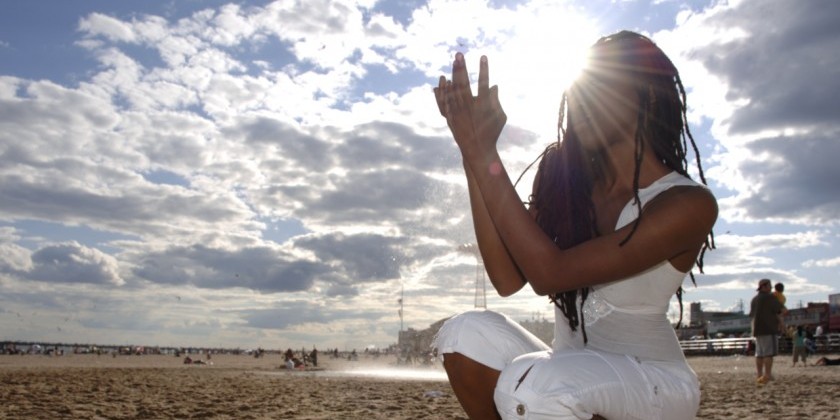Moving Caribbean in New York City: Trindad Native Makeda Thomas on Island Ways & the light fantastical at Brooklyn College

Makeda Thomas is in Trinidad and I am in New York City, but it feels as if we could be in the same room. The spirits of technology and our mutual desire to talk of Caribbean matters enable us to cross the water for a chat. Being from the Caribbean, I am always interested to learn of the island experiences of others. I miss the melodious accents particular to each island and Thomas's takes me home.
This exciting artist — a dancer, author, scholar, curator, choreographer, site-specific creator, teacher, filmmaker, and founder of the 2010 Institute for Performance and Dance Studies in Trinidad — (phew), is no stranger to travel.

During her childhood in the 1980’s Thomas remembers her mother wanting to move to New York; the hope for economic security stateside was prevalent. So they left.
Thomas’s father, a founder of the Nantambu Drummers in Trinidad, knew “security” would be elusive for a musician wherever he worked, so he opted to stay home. Makeda recalls her dad saying, “The only place in the world that I want to go is Africa, and Trinidad is as close as I am going to get, so it makes no sense for me to go anywhere.” This meant that she moved frequently. “We would be out of New York two weeks before school ended, and would come back two weeks after school started in order to spend a good four-month chunk of time in the Caribbean with my dad. I have always been back and forth and living in both spaces.”
Transition to stateside life wasn’t stressful. In fact, because her mother’s Trinidadian family lived in New York and she grew up in the very Caribbean East Flatbush, Thomas doesn’t remember a dramatic shift. “Though I was definitely having an American experience, there was Caribbean everywhere,” she says. “Caribbean accents, food… Our neighbors were Guyanese, Haitian, and Cuban.”
The community village aspect of life was a vital component to her happiness then, and now, as she travels with her six-year-old son while working between New York and Trinidad, she holds on to its power. “I love the idea of the village around us. This is a very Caribbean value. You can’t pass a grown up in the street without saying, “good morning” or “good afternoon.” My son is responsible to and addresses all of my friends as aunty and uncle. He’s accountable.”

I mull over how to address Thomas. She moves seamlessly through so many distinct areas of the dance field. Where can I start?
Her Costa del Alma, a film in which she dances, created in 2008 off the coast of Mozambique, is a stirring cinematic work that also lives as an academic article — one of the first she ever wrote — in the Caribbean journal “Small Axe.” Her most known theatrical piece Fresh Water which premiered in Trinidad in 2006, has been performed in Mozambique, Zimbabwe, Mexico, and in the states, notably at Brooklyn Museum, and Seattle’s Broadway Performance Hall.

Filled with gestures and symbols of Trinidad, illuminating and turning around Caribbean types, Fresh Water currently exists as part of MIT’s OpenCourseWare initiative, embedded in the course Black Matters: Introduction to Black Studies at Massachusetts Institute of Technology —quite an honor, Thomas admits. Then there is her ambitious Institute for Performance and Dance Studies dedicated to researching, documenting and advancing Caribbean and African diasporic dance and culture. While Thomas will say she is a dancer’s dancer first and foremost, the fact that she can leap from stage, to film, to academic theory, to creating spaces for art, must be thrilling and freeing.

Her latest endeavor, part of the CUNY Dance Initiative (CDI), finds Thomas experimenting with art installation. I can’t wait to see what that looks like,” she says, laughing.” the light fantastical will premiere at Brooklyn College next year. “I will probably be talking about it for the next two years. It is manifesting as theater, with a live performance version, two essays, a film, and …”
The opportunity to be active in her mostly Caribbean Brooklyn community, to have Caribbean students talk to her about her work, inspires Thomas greatly. What doesn’t inspire her is going to any art event that defines their Caribbean section simply as a Carnivalesque Jump Up. “I want to die,” she says. “It’s so flat. We are more layered with depth, and more nuanced. We are bigger than that.”
“The core of my work is challenging, opening and exploding,” Thomas explains. “Exploding the idea of what Caribbean-ness is and how it can be expressed. I even hesitate to use soca music for that reason. While I used it in Fresh Water, it was in a sort of tongue-in- cheek way.”

We both agree that a Caribbean vision has much to offer the world, and as we prepare to leave our island-to-island talk session, I ask what she sees as vital for the world-at-large to learn from Caribbean culture.
“Cultures that are bigger than ours are just now getting to conversations around multiculturalism, diversity, and race. We have been living and breathing this since our beginnings, so we are prepared to lead these conversations, AND not only to lead but to reveal a sort of ease about how multiculturalism exists in our space — an ease that many people can’t fathom.”













